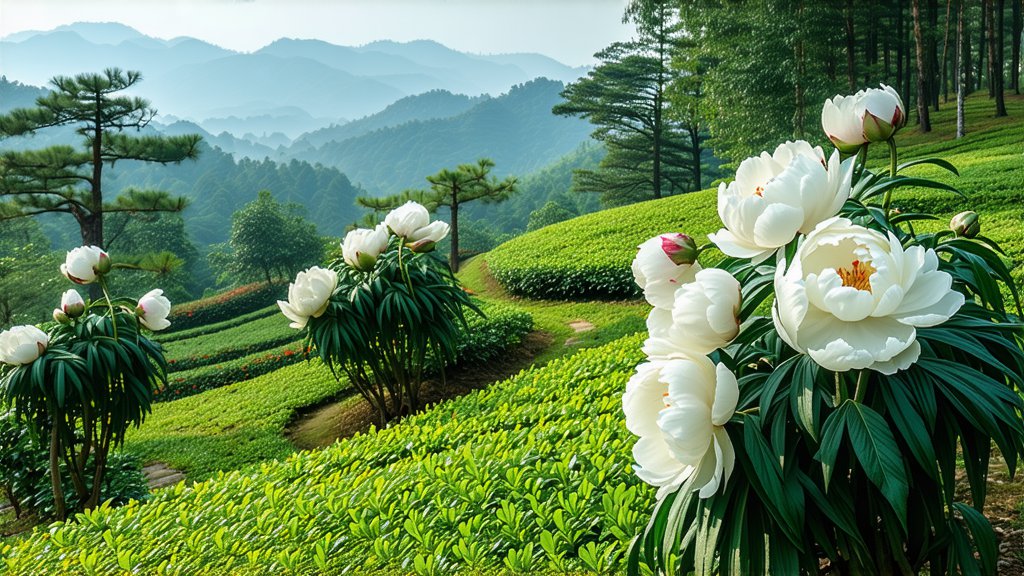
In the vast and diverse tapestry of Chinese tea culture, few varieties capture the imagination quite like the Fujian White Peony Tea, known as Bai Mudan (白牡丹) in Mandarin. This ethereal elixir, hailing from the verdant mountains of Fujian Province, offers a sensory experience that transcends time and geography. For those unfamiliar with this exquisite tea, allow me to guide you through its storied past, intricate production process, and the art of its appreciation.
Historical Roots
The origins of Bai Mudan can be traced back to the Tang Dynasty (618-907 AD), though it wasn't until the Qing Dynasty (1644-1912) that it gained significant prominence. Legend has it that the tea was discovered by accident when a heavy rain caused the leaves of a tea plant to remain covered for several days, leading to a unique transformation. This serendipitous event resulted in the creation of a tea that combined the delicate flavors of green tea with the subtle sweetness associated with white tea. Bai Mudan, therefore, represents a harmonious blend of nature's whimsy and human ingenuity.
Varietals and Classification
Bai Mudan falls under the category of white teas, which are among the least processed of all tea types. It is distinct from other white teas like Silver Needle (Bai Hao Yin Zhen) due to its inclusion of both buds and young leaves, giving it a more complex flavor profile. The name "White Peony" is derived from the appearance of the dried leaves, which resemble the petals of a peony flower. There are two main grades of Bai Mudan: Superior and First-Class, with Superior being the most prized for its higher proportion of buds to leaves and finer quality.
Crafting the Elixir
The production of Bai Mudan is an art form that requires precision and patience. It begins in early spring when only the top buds and the first few leaves of the Camellia sinensis plant are handpicked. These are then withered under the sun or indoors in a controlled environment, allowing them to lose moisture without losing their natural essence. After withering, the leaves undergo a light oxidation process, followed by a gentle bake or sun drying to fix the flavors. The final product is a testament to the tea master's skill in balancing tradition and innovation.
A Symphony of Flavors
Tasting Bai Mudan is akin to embarking on a journey through a fragrant garden. Upon brewing, the tea releases a bouquet reminiscent of honey, melon, and a hint of floral sweetness. The initial sip reveals a smooth, mellow taste with a lingering sweetness that dances on the palate. Subtle vegetal undertones and a touch of fruitiness add depth to the experience. As the session progresses, one may detect nuances of woodiness and a whisper of minerality, reflecting the terroir of the Fujian highlands.
The Art of Appreciation
To truly appreciate Bai Mudan, one must adopt a mindful approach to tea drinking. Begin by selecting a clear glass or porcelain teapot to observe the unfurling leaves, a visual spectacle in itself. Use water heated to around 80-85°C (176-185°F) to avoid scalding the delicate leaves. Allow the tea to steep for approximately 3-5 minutes, adjusting based on personal preference for strength. Savor each sip slowly, allowing the flavors to unfold gradually, and take note of how they evolve with each subsequent brewing.
Conclusion
Fujian White Peony Tea, or Bai Mudan, stands as a testament to China's rich tea heritage and the artistry involved in tea making. From its serendipitous discovery centuries ago to its status as a cherished delicacy today, Bai Mudan encapsulates the essence of simplicity and elegance. Whether you are a seasoned connoisseur or a curious novice, exploring the world of Bai Mudan promises a captivating adventure for the senses and a deeper connection to the ancient traditions that continue to shape our understanding of this beloved beverage.